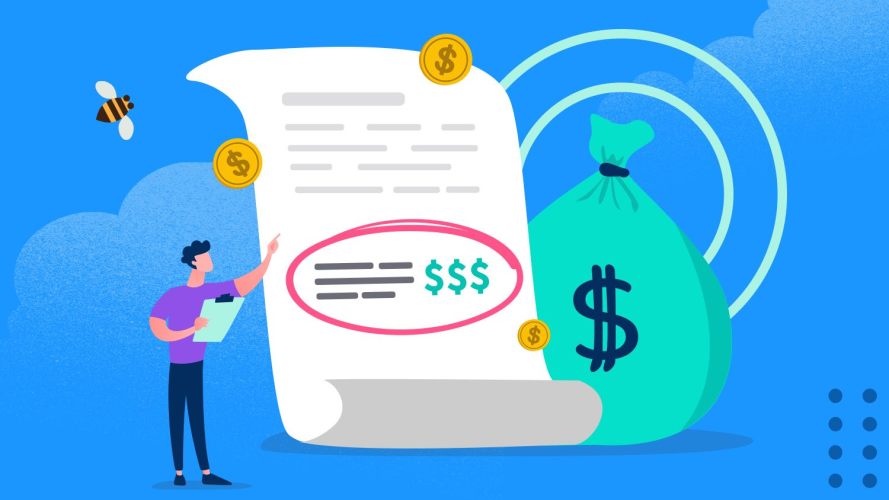3 Ways Generative AI Will Help Marketers Connect With Customers
3 min read

Designing sales compensation plans is a delicate balancing act. An effective comp plan simultaneously incentivizes sales performance and protects the company against financial crisis. These competing priorities lead many organizations to implement one of the most consequential — and sometimes controversial — provisions you’ll find in a compensation plan: the clawback clause.
In this article, we’ll walk you through the ins and outs of clawbacks to help you leverage their benefits and avoid the most common clawback pitfalls.
Use a single platform to give sellers access to commission statements and track progress against goals and potential earnings, all while aligning organizational priorities to seller motivations.



A clawback clause, or clawback provision, refers to a “contractual obligation to return money under special circumstances or events,” according to the Corporate Finance Institute.
For sales organizations, this type of clause or provision enables a business to reclaim commission or other performance-based compensation paid to a salesperson under specific circumstances. Most clawbacks require a salesperson to return previously paid commission when a customer churns or cancels their purchase within a designated time period. For example, an organization may institute a three-month clawback, which states that a sales rep must return any earned commission if a customer cancels their plan within three months of signing up.
Clawbacks have been widely used as part of employment contracts across many industries, particularly since the financial crash of 2008, as a means to protect a business against fraudulent activity. In fact, research shows that between 2005 and 2010, the percentage of Fortune 500 companies that used clawbacks rose from fewer than 3% to a whopping 82%.
A sales clawback clause is more than just a financial insurance policy for an organization. Though it mainly serves a protective function, when implemented correctly, this type of provision can deliver a variety of benefits.
Here are the key reasons why companies use sales clawback clauses.
The primary function of a clawback clause is to protect an organization from financial losses that will impede its growth. This provision is particularly critical for companies that sell SaaS products.
For example, if a customer cancels their subscription shortly after signing up, the vendor doesn’t earn much from the deal in the long term. But, the sales rep who initially closed the deal might’ve received a substantial commission payment. Without the proper provisions in place, customer churn doesn’t impact the sales rep, but does result in a loss for the business, which still had to pay commission on a deal that didn’t stick.
A clawback clause prevents this scenario by enabling the business to reclaim commission payouts that stem from a deal they deem as unfulfilled.
While no company wants to believe their employees might engage in fraudulent behavior, clawback clauses protect the business in the rare event of misconduct. They give the business legal grounds to reclaim payment from deals made under false pretenses, or ones that violate company policies or compliance laws.
Additionally, the inclusion of a clawback clause serves as a deterrent against fraudulent activity, whether it’s the result of intentional misconduct or negligent behavior.
No sales rep wants to pay back the commission they earn. Therein lies the biggest indirect benefit of clawback clauses. They promote sales behaviors that contribute to sustainable business growth rather than wins at any cost — regardless of a buyer’s fit, need, or qualifying criteria.
When sales reps know their commission is at risk of being clawed back, they’ll pursue high-quality deals and be more diligent when it comes to qualifying prospects.
Likewise, a clawback clause encourages sales reps to play a role in improving customer experience. Rather than cash their commission check and forget about a customer, a rep will want to follow up during the onboarding process and ensure the customer’s satisfaction. Businesses — especially SaaS providers — value long-term business over initial sales. Clawback clauses simply give sales reps a little extra motivation to embrace the same philosophy.
Any process in which an employer reclaims compensation paid to an employee is not one to be taken lightly. When implemented correctly, a clawback clause protects an organization. If an organization misses the mark, however — either in terms of design or execution — it will have the opposite effect.
Let’s look at some of the risks companies face when implementing a provision that has the potential to reclaim paid earnings from sales personnel.
For sales reps, clawbacks create a sense of uncertainty and a lack of control over outcomes. As a result, these clauses can have an unintended impact on rep behavior and make them overly risk-averse.
Remember how we said that clawback clauses can incentivize good sales behavior? Well, there’s another side to that coin — sometimes, reps respond to the threat of a clawback by playing it too safe, dismissing quality opportunities that pose even the slightest risk of not working out.
Clawback clauses might push sales reps to adopt other behaviors that are detrimental to the business. A common one: shadow accounting.
Shadow accounting is a practice in which individual sales reps keep track of their own deals and incentive-based compensation, typically to ensure that their compensation will be accurate. A complicated clause may lead to additional time spent tracking the status of recent deals, distracting sellers from their primary selling responsibilities. In other words: Their concern over potential clawbacks makes them less productive, impacting their ability to focus on closing new deals.
Without the right systems in place, clawback clauses can become a nightmare for your finance team. They introduce an extra degree of complexity to already complex sales compensation plans — and even clauses that are clear and specific on paper can create ambiguity and confusion when put into practice.
This process can become a burden for finance teams and increase stress, as a single administrative mistake when implementing a clawback can prove to be disastrous. And, if they struggle to communicate the parameters and status of clawbacks to sales reps, they’ll cultivate distrust between the two departments.
All of these factors also make it difficult to prepare accurate financial reports and reconcile financial statements.
The pitfalls of a poorly implemented clawback clause (diminished morale, loss of trust, hostility between sales and finance) can ultimately cause an increase in sales turnover.
When sales reps know their commission can be taken back by their employer — and worse, when they don’t fully understand why their earnings are being reclaimed — they may be inclined to pursue a more secure sales position at another company.
Last but not least, clawback clauses can expose an organization to lawsuits and other legal ramifications. The 2017 Oracle lawsuit is a great example, in which the technology company was sued for $150 million over clawed back sales wages.
While most clawbacks are legal, they must abide by several federal and state regulations. And, even if the contracts themselves adhere to these regulations, a single miscalculation or accounting error can put a company at risk.
There’s no one-size-fits-all approach to building out an incentive compensation plan — and likewise, there’s more than one type of clawback clause a company can implement. So, now that you understand the benefits and risks of clawback clauses, let’s get a bit more specific and break down three types of clawback clauses a company might use.
The simplest — and thus most common — type of clawback clause requires sales reps to return the exact dollar amount of commission they earned if the customer cancels within the clawback duration.
Let’s say a sales rep closes a $150,000 deal for which they earned 5% commission, or $7,500. The customer drops the subscription product two months later, triggering the four-month clawback provision that the rep’s employer has implemented. In this scenario, the rep must return their $7,500 commission payment.
Rather than require a sales rep to return the exact commission payment of an unfulfilled deal, this type applies a negative credit to their quota for the current pay period if a customer leaves before the end of the clawback window. While less straightforward than the previous example, this process is popular among businesses that use a tiered commission structure, as it aims to prevent over-attainment.
For example, let’s say a sales rep earns 5% commission up to $450,000 in sales per quarter. Once they cross that threshold, they earn 10% commission on any subsequent deals they close that quarter.
This rep closes a $50,000 deal in March (Q1), but in May (Q2), the customer cancels their subscription, which puts the deal within the four-month clawback window the rep’s company has implemented. The rep receives a negative credit of -$50,000 towards their Q2 quota — meaning they now have to bring in $500,000 that quarter in order to reach the 10% commission tier.
While this method mitigates the financial risks of over-attainment, it comes with significant downsides. For starters, it’s demotivating to sales reps, as they might feel that a negative credit makes it impossible to hit their quota. This method may also encourage bad sales habits; if a rep doesn’t believe they can hit their quota in the current quarter due to a clawback, they might try to stall or sandbag a deal until the following quarter when they’ll have a fresh start.
This type of clawback clause is the most complicated, so bear with us. Instead of attributing a negative credit to the sales rep’s quota in the current period, the clawback is retroactively applied to their quota attainment for the period in which the deal took place.
Let’s illustrate this method using the same example from above: A rep closes a $50,000 deal in March and the customer cancels in May. The rep adheres to a tiered commission structure: 5% commission until they hit $450,000, 10% for additional deals that quarter.
Rather than impact their Q2 quota attainment, this clawback method retroactively reduces their Q1 quota attainment by $50,000. So, let’s say the rep exceeded their quota in Q1 and then closed one additional deal, for which they earned 10% commission. But, with the clawback implemented, the rep’s Q1 quota attainment drops below $450K so they owe the company the additional 5% they earned on that last deal, since they (retroactively) didn’t reach the second tier of their commission plan.
You can probably guess the biggest drawback of this approach: It’s complicated. Not only does it put a strain on finance teams, but it’s difficult to communicate to sales reps. No matter how transparent you are, reps might feel betrayed to learn that their accomplishment of exceeding quota in the previous quarter is being taken away from them.

3 min read

6 min read
At this point, you might be wondering: Do clawback clauses do more harm than good? If you’ve yet to implement this process, the risks associated with clawbacks can indeed seem overwhelming. But, there are several steps you can take to ensure your organization benefits from clawback clauses while avoiding any unintended negative consequences.
Because the Securities and Exchange Commission has specific regulations regarding clawbacks, it’s important to make sure you work closely with your legal team when designing and implementing a clawback clause in your sales compensation plans.
Compensation laws can vary from state to state and undergo frequent changes, so you must take every precaution to ensure that your clawback clause remains compliant with applicable regulations.
Design clawback clauses with crystal-clear parameters and durations. Use specific and unambiguous language that explains what actions trigger a clawback, the timeframe in which a deal is subject to the provision, and what earnings a sales rep will forfeit in the event of a clawback.
Remember: Clawbacks are supposed to be protective, not punitive. Reclaiming excessive amounts or imposing long clawback durations will only result in demotivation and distrust.
So, while more complex methods have their merits, the safest route is to keep your clawback clauses as simple as possible. Consider the example we included above: If the customer churns within four months, the rep returns the commission they earned. That’s easy to enforce and understand.
It’s always important to foster a transparent relationship between finance and sales teams — especially when it comes to sensitive topics like pay.
Establish a process for communicating specifics to all sales employees. Don’t make them dig through convoluted documentation. Provide them with straightforward, easy-to-digest resources that answer the most pressing questions about clawbacks.
Keep in mind: Informing sales reps on what the clause entails is only half the battle. You should also take the necessary steps to explain why the clause exists. Communicate how this provision protects the business, and provide them with general best practices for avoiding clawback.
Your team likely reviews, updates, and improves compensation plans on a regular basis — and you should take the same approach to your clawback clauses. At least once per calendar year, analyze previous deals that triggered the clawback clause and determine what impact it made, both on the business’s bottom line and sales performance.
If you find that clawbacks have had a disproportionately negative impact, determine what improvements you can make. For example, you might consider shortening the clawback window or decreasing the percentage of earnings that sales reps forfeit.
A manual clawback process places a great burden on finance and accounting teams, both in terms of workload and stress. It’s a complicated process that impacts important teams and functions. That’s why we recommend leveraging an incentive compensation management solution that enables you to fully automate the clawback process when a deal triggers the provision.
Automating clawbacks will also help to prevent hostility between finance and sales. When clawbacks happen automatically, sales reps may be less likely to feel like the finance team is actively choosing to “take their money” from them and more likely to assess what they can do to avoid repeating the same scenario moving forward.
Ultimately, the impact of a clawback clause relies on two variables: intent and execution. If you implement a clawback solely to maximize profit, without prioritizing fairness and transparency, these provisions can hurt your business in the long run. On the other hand, if you take a deliberate and empathetic approach to clawbacks, you’ll help reps sell more effectively and deliver meaningful value to the business.
Provide sellers with real-time visibility into incentive pay while automating the administrative work that bogs down teams and delays pay.




Get the latest articles in your inbox.


